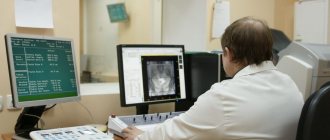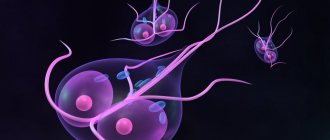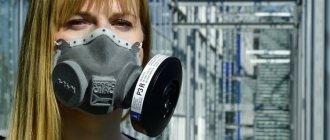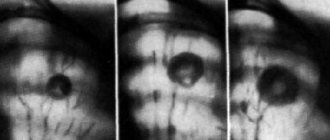Table 1. Qualitative and quantitative composition of the main microflora of the large intestine in healthy people (CFU/g Feces)
(Industry standard 91500.11.0004-2003 “Protocol for the management of patients. Intestinal dysbiosis” - APPROVED by order of the Ministry of Health of Russia dated 06/09/2003 N 231)
| Types of microorganisms | Age, years | ||
| < 1 | 1-60 | > 60 | |
| Bifidobacteria | 1010 — 1011 | 109 — 1010 | 108 – 109 |
| Lactobacilli | 106 — 107 | 107 – 108 | 106 — 107 |
| Bacteroides | 107 – 108 | 109 — 1010 | 1010 — 1011 |
| Enterococci | 105 — 107 | 105 – 108 | 106 – 107 |
| Fusobacteria | < 106 | 108 – 109 | 108 – 109 |
| Eubacteria | 106 — 107 | 109 — 1010 | 109 — 1010 |
| Peptostreptococci | < 105 | 109 — 1010 | 1010 |
| Clostridia | <= 103 | <= 105 | <= 106 |
| Escherichia (E.coli): | |||
| E. coli typical | 107 – 108 | 107 – 108 | 107 – 108 |
| E. coli lactose negative | < 105 | < 105 | < 105 |
| E. coli hemolytic | 0 | 0 | 0 |
| Other opportunistic enterobacteria <*> | < 104 | < 104 | < 104 |
| Staphylococcus aureus | 0 | 0 | 0 |
| Staphylococci (saprophytic, epidermal) | <= 104 | <= 104 | <= 104 |
| Yeast-like fungi of the genus Candida | <= 103 | <= 104 | <= 104 |
| Non-fermenting bacteria <**> | <= 103 | <= 104 | <= 104 |
<*> - representatives of the genera Klebsiella, Enterobacter, Hafnia, Serratia, Proteus, Morganella, Providecia,
Citrobacter etc.
<**> - Pseudomonas, Acinetobacter, etc.
The microorganisms listed in the dysbacteriosis analysis form can be divided into three groups:
- lactic acid bacteria of normal microflora - mainly bifidobacteria and lactobacilli,
- pathogenic enterobacteria,
- opportunistic pathogenic flora (OPF).
Lactic acid bacteria
The basis of the normal intestinal microflora is lactic acid bacteria - bifidobacteria, lactobacilli and propionic acid bacteria with a predominance of bifidobacteria, which play a key role in maintaining the optimal composition of the biocenosis and its functions. A drop in the number of bifidobacteria and lactobacilli below normal indicates the presence of problems in the body. At a minimum, this is inflammation on the mucous membranes and a decrease in immune defense.
Pathogenic enterobacteria
Pathogenic enterobacteria are bacteria that can cause acute intestinal infections (the causative agents of typhoid fever are Salmonella, the causative agents of dysentery are Shigella, the causative agents of yersiniosis are Yersinia, etc.). Their presence in feces is no longer just dysbacteriosis, but an indicator of a dangerous infectious intestinal disease.
Opportunistic pathogenic flora (OPF)
Opportunistic flora includes lactose-negative enterobacteria, clostridia, various cocci, etc. The essence of these microbes is reflected in the name of the group: “opportunistic”. Normally they do not cause any problems. Many of them can even be beneficial to the body to a certain extent. But if the norm is exceeded and/or the immune defense is ineffective, they can cause serious diseases. By competing with beneficial bacteria, opportunistic flora can become part of the intestinal microbial film and cause functional disorders, inflammatory and allergic diseases.
It is possible for opportunistic flora to enter the blood through the intestinal wall and spread throughout the body (translocation), which is especially dangerous for young children and people with severe immunodeficiencies, in whom these microorganisms can cause various diseases, including life-threatening ones.
Explanations for the table
Typically, the number of detected bacteria in the analysis form is indicated by the number 10 to some degree: 103, 105, 106, etc. and the abbreviation CFU/g, which means the number of living bacteria capable of growing in 1 g of feces.
The abbreviation “abs” next to the name of the bacterium means that this microorganism was not found within the normal range or above it, and values below the norm (subnormal) were not considered as insignificant.
Bifidobacteria
Bifidobacteria are the basis of the normal microflora of the large intestine. Normally, their content in the intestines should be 1010-1011 in children under one year old, and 109-1010 CFU/g in adults. A noticeable decrease in the number of bifidobacteria is the main sign of the presence of dysbiosis and immune disorders.
Deficiency of bifidobacteria leads to increased intoxication, disruption of carbohydrate metabolism, absorption and assimilation of vitamins, calcium, iron and other micro- and macroelements in the intestines. Without a biofilm of bifidobacteria, the structure of the intestinal mucosa changes and the functions of the intestinal mucosa are disrupted, the number of immune cells and their activity decreases, and intestinal permeability to foreign agents (toxins, harmful microbes, etc.) increases. As a result, the toxic load on the liver and kidneys significantly increases, the risk of developing infections and inflammations, vitamin deficiencies and various microelementoses increases.
Lactobacilli
Lactobacilli, as well as bifidobacteria, are one of the main components of normal human microflora. The normal content in the intestines of children under one year of age is 106 - 107, in adults - 107-108 CFU/g. A significant decrease in the number of lactobacilli indicates not only dysbiotic disorders, but also that the body is in a state of chronic stress, as well as a decrease in antiviral and antiallergic protection, disorders of lipid metabolism, histamine metabolism, etc. Lactobacillus deficiency greatly increases the risk of developing allergic reactions, atherosclerosis, neurological disorders, cardiovascular diseases, can also cause constipation and the development of lactase deficiency.
Bacteroides
Bacteroides are opportunistic bacteria. The second largest group (after bifidobacteria) of intestinal microorganisms, especially in adults (the norm is up to 1010 CFU/g), in children under one year of age - 107-108. When kept within normal limits, they perform many beneficial functions for the body. But if the balance in the intestinal microcenosis is disturbed or if the norm is exceeded, bacteroids can lead to a variety of infectious and septic complications. With excessive growth, bacteroids can suppress the growth of E. coli by competing with it for oxygen. The uncontrolled growth of bacteroids and their manifestation of aggressive properties limit the main components of the protective flora - bifidobacteria, lactobacilli and propionic acid bacteria.
Enterococci
Enterococci are the most common opportunistic microorganisms found in the intestines of healthy people. The content norm for children under one year is 105-107, for adults – 105-108 (up to 25% of the total number of coccal forms). Some experts consider them harmless. In fact, many enterococci are capable of causing inflammatory diseases of the intestines, kidneys, bladder, reproductive organs, not only when they exceed the permissible amount (with a content of more than 107), but also in an amount corresponding to the upper limit of normal (106-107), especially in humans with reduced immunity.
Fusobacteria
Fusobacteria are opportunistic bacteria, the main habitats of which in the human body are the large intestine and the respiratory tract. The oral cavity of an adult contains 102-104 CFU/g of fusobacteria. The permissible amount in the intestines in children under one year of age is < 106, in adults - 108 - 109.
Some types of fusobacteria in immunodeficiencies can cause secondary gangrenous and purulent-gangrenous processes. With tonsillitis, herpetic stomatitis, malnutrition in children, and immunodeficiency states, the development of fusospirochetosis is possible - a necrotic inflammatory process on the tonsils and oral mucosa.
Eubacteria (lat. Eubacterium)
They belong to the main resident microflora of both the small and large intestines of humans and make up a significant part of all microorganisms inhabiting the gastrointestinal tract. The permissible amount of eubacteria in the stool of healthy people: in children of the first year - 106-107 CFU/g; in children over one year old and adults, including the elderly - 109-1010 CFU/g.
Approximately half of the species of eubacteria living in the human body can participate in the development of inflammation of the oral cavity, the formation of purulent processes in the pleura and lungs, infective endocarditis, arthritis, infections of the genitourinary system, bacterial vaginosis, sepsis, abscesses of the brain and rectum, and postoperative complications.
An increased content of eubacteria is found in the feces of patients with colon polyposis. Eubacteria are rarely found in breastfed children, but in bottle-fed children they can be detected in quantities corresponding to the norm for an adult.
Peptostreptococci
Peptostreptococci belong to the normal human microflora. The normal content in feces in children under one year of age is <105, in children over one year of age and adults - 109 - 1010. In the body of a healthy person, peptostreptococci live in the intestines (mainly in the colon), oral cavity, vagina, and respiratory tract. Typically, peptostreptococci are causative agents of mixed infections, manifesting themselves in associations with other microorganisms.
Clostridia
Opportunistic bacteria, representatives of putrefactive and gas-forming flora, the number of which depends on the state of local intestinal immunity. The main habitat in the human body is the large intestine. The permissible amount of clostridia in children under one year of age is no more than 103, and in adults - up to 105 CFU/mg.
In combination with other opportunistic flora, clostridia can cause stool liquefaction, diarrhea, and increased gas formation, which, along with the rotten smell of feces (symptoms of putrefactive dyspepsia), is an indirect sign of increased numbers and activity of these bacteria. Under certain conditions, they can cause necrotic enteritis and cause foodborne illness, accompanied by watery diarrhea, nausea, abdominal cramps, and sometimes fever.
When taken with certain antibiotics, clostridia can cause antibiotic-associated diarrhea or pseudomembranous colitis. In addition to intestinal problems, clostridia can cause diseases of the human genitourinary organs, in particular acute prostatitis. The symptoms of inflammation caused by clostridia in the vagina are similar to the symptoms of candidal vaginitis (“thrush”).
E.coli typical (Eschechiria, E. coli typical) , i.e. with normal enzymatic activity
Opportunistic microorganisms, which, together with bifidobacteria and lactobacilli, belong to the group of protective intestinal microflora. This bacillus prevents the colonization of the intestinal wall by foreign microorganisms, creates comfortable conditions for other important intestinal bacteria, for example, absorbs oxygen, which is a poison for bifidobacteria. This is the main “vitamin factory” in the body.
Normally, the total content of E. coli is 107-108 CFU/mg (which corresponds to 300-400 million/g). Elevated levels of E. coli in the intestines can cause inflammation, accompanied by stool problems and abdominal pain. And its penetration from the intestines into other ecological niches of the body (urinary tract, nasopharynx, etc.) is the cause of cystitis, kidney diseases, etc.
A decrease in this indicator is a signal of a high level of intoxication in the body. A strong decrease in the number of typical E. coli (up to 105 CFU/mg and below) is an indirect sign of the presence of parasites (for example, worms or parasitic protozoa - Giardia, blastocysts, amoebas, etc.). In addition to parasites, among the most likely reasons for a decrease in E. coli levels are the existence of foci of chronic infection in the body, increased allergization, dysfunction or diseases of various organs, primarily the liver, kidneys, pancreas and thyroid glands. To avoid misdiagnosis and, accordingly, incorrect treatment, it is recommended to first exclude parasitic infection.
Escherichia coli with reduced enzymatic activity (E.coli lactose-negative).
The content rate is no more than 105 CFU/g. This is an inferior variety of E. coli, which usually does not pose a direct danger. But this stick is a parasite. It takes the place of full-fledged E.coli, without performing the beneficial functions inherent in full-fledged E.coli. As a result, the body does not receive enough vitamins, enzymes and other beneficial substances synthesized by full-fledged Escherichia, which ultimately can lead to serious metabolic disorders and even inflammatory diseases. The presence of this bacillus in quantities above the permissible norm is always a sign of incipient dysbiosis and, along with a decrease in the total amount of E. coli, can be an indirect indicator of the presence of parasitic protozoa or worms in the intestines.
E. coli hemolytic (hemolytic Escherichia coli)
Pathogenic variant of Escherichia coli. Normally it should be absent. Its presence requires immunocorrection. May cause allergic reactions and various intestinal problems, especially in young children and those with weakened immune systems. It often forms pathogenic associations with Staphylococcus aureus, but unlike it, it is practically not found in breast milk.
Coprogram
A coprogram is a study of feces (feces, excrement, stool), an analysis of its physical and chemical properties, as well as various components and inclusions of various origins. It is part of a diagnostic study of the digestive organs and the function of the gastrointestinal tract.
Synonyms Russian
General stool analysis.
English synonyms
Koprogramma, Tool analysis.
Research method
Microscopy.
What biomaterial can be used for research?
Cal.
How to properly prepare for research?
Avoid taking laxatives, administering rectal suppositories, oils, limit taking medications that affect intestinal motility (belladonna, pilocarpine, etc.) and the color of stool (iron, bismuth, barium sulfate) for 72 hours before donating stool.
General information about the study
A coprogram is a study of feces (feces, excrement, stool), an analysis of its physical and chemical properties, as well as various components and inclusions of various origins. It is part of a diagnostic study of the digestive organs and the function of the gastrointestinal tract.
Feces are the final product of food digestion in the gastrointestinal tract under the influence of digestive enzymes, bile, gastric juice and the activity of intestinal bacteria.
The composition of feces is water, the content of which is normally 70-80%, and a dry residue. In turn, the dry residue consists of 50% living bacteria and 50% from the remains of digested food. Even within normal limits, the composition of stool is largely variable. It largely depends on nutrition and fluid intake. The composition of feces varies even more in various diseases. The amount of certain components in the stool changes with pathology or dysfunction of the digestive organs, although deviations in the functioning of other body systems can also significantly affect the activity of the gastrointestinal tract, and therefore the composition of stool. The nature of changes in various types of diseases is extremely diverse. The following groups of violations of the composition of feces can be distinguished:
- change in the amount of components that are normally contained in stool,
- undigested and/or undigested food remains,
- biological elements and substances secreted from the body into the intestinal lumen,
- various substances that are formed in the intestinal lumen from metabolic products, tissues and cells of the body,
- microorganisms,
- foreign inclusions of biological and other origin.
What is the research used for?
- For the diagnosis of various diseases of the gastrointestinal tract: pathologies of the liver, stomach, pancreas, duodenum, small and large intestine, gall bladder and biliary tract.
- To evaluate the results of treatment of diseases of the gastrointestinal tract requiring long-term medical supervision.
When is the study scheduled?
- For symptoms of any disease of the digestive system: pain in various parts of the abdomen, nausea, vomiting, diarrhea or constipation, changes in the color of feces, blood in stool, loss of appetite, loss of body weight despite satisfactory nutrition, deterioration in the condition of skin, hair and nails, yellowness of the skin and/or whites of the eyes, increased gas formation.
- When the nature of the disease requires monitoring the results of its treatment during therapy.
What do the results mean?
Reference values
| Index | Reference values |
| Consistency | Dense, shaped, hard, soft |
| Form | Shaped, cylindrical |
| Smell | Fecal, sour |
| Color | Light brown, brown, dark brown, yellow, yellow-green, olive |
| Reaction | Neutral, weakly acidic |
| Blood | No |
| Slime | None, small quantity |
| Leftover undigested food | None |
| Muscle fibers are changed | Large, moderate, small amount, none |
| Muscle fibers unchanged | None |
| Detritus | Absent, small, moderate, large amount |
| Digestible plant fiber | None, small quantity |
| Fat neutral | Absent |
| Fatty acid | None, small quantity |
| Soap | None, small quantity |
| Intracellular starch | Absent |
| Extracellular starch | None |
| Red blood cells | 0 — 1 |
| Crystals | No, cholesterol, activated carbon |
| Iodophilic flora | Absent |
| Clostridia | None, small quantity |
| Yeast-like fungi | None |
Consistency/shape
The consistency of the stool is determined by the percentage of water it contains. The normal water content in feces is 75%. In this case, the stool has a moderately dense consistency and a cylindrical shape, i.e., stool is formed. Eating an increased amount of plant foods containing a lot of fiber leads to increased intestinal motility, and the feces become mushy. A thinner, watery consistency is associated with an increase in water content to 85% or more.
Liquid, mushy stool is called diarrhea. In many cases, stool liquefaction is accompanied by an increase in the quantity and frequency of bowel movements during the day. According to the mechanism of development, diarrhea is divided into those caused by substances that interfere with the absorption of water from the intestine (osmotic), resulting from increased secretion of fluid from the intestinal wall (secretory), resulting from increased intestinal peristalsis (motor) and mixed.
Osmotic diarrhea often occurs as a result of impaired breakdown and absorption of food elements (fats, proteins, carbohydrates). Occasionally, this can occur when consuming certain indigestible osmotically active substances (magnesium sulfate, salt water). Secretory diarrhea is a sign of inflammation of the intestinal wall of infectious and other origins. Motor diarrhea can be caused by certain medications and dysfunction of the nervous system. Often the development of a particular disease is associated with the involvement of at least two mechanisms of diarrhea; such diarrhea is called mixed.
Hard stool occurs when the movement of stool through the large intestine slows down, which is accompanied by excessive dehydration (water content in stool is less than 50-60%).
Smell
The usual mild smell of feces is associated with the formation of volatile substances that are synthesized as a result of bacterial fermentation of protein elements in food (indole, skatole, phenol, cresols, etc.). This odor intensifies with excessive consumption of protein foods or insufficient consumption of plant foods.
The sharp foul odor of feces is due to increased putrefactive processes in the intestines. A sour smell occurs with increased fermentation of food, which may be associated with a deterioration in the enzymatic breakdown of carbohydrates or their absorption, as well as with infectious processes.
Color
The normal color of stool is due to the presence of stercobilin, the end product of bilirubin metabolism, which is released into the intestines with bile. In turn, bilirubin is a breakdown product of hemoglobin, the main functional substance of red blood cells (hemoglobin). Thus, the presence of stercobilin in feces is the result, on the one hand, of the functioning of the liver, and on the other, the constant process of updating the cellular composition of the blood. The color of stool normally varies depending on the composition of the food. Darker stool is associated with the consumption of meat foods, while a dairy-vegetable diet leads to lighter stools.
Discolored feces (acholic) is a sign of the absence of stercobilin in the stool, which can be caused by the fact that bile does not enter the intestines due to blockage of the biliary tract or a sharp violation of the biliary function of the liver.
Very dark Kalinogda is a sign of increased concentration of stercobilin in the stool. In some cases, this is observed with excessive breakdown of red blood cells, which causes increased excretion of hemoglobin metabolic products.
Red flowers may be caused by bleeding from the lower intestines.
Black color is a sign of bleeding from the upper gastrointestinal tract. In this case, the black color of the stool is a consequence of the oxidation of hemoglobin in the blood by hydrochloric acid of the gastric juice.
Reaction
The reaction reflects the acid-base properties of the stool. An acidic or alkaline reaction in feces is due to the increased activity of certain types of bacteria, which occurs when food fermentation is disrupted. Normally, the reaction is neutral or slightly alkaline. Alkaline properties increase with the deterioration of enzymatic breakdown of proteins, which accelerates their bacterial decomposition and leads to the formation of ammonia, which has an alkaline reaction.
The acid reaction is caused by the activation of bacterial decomposition of carbohydrates in the intestines (fermentation).
Blood
Blood in the stool occurs when there is bleeding in the gastrointestinal tract.
Slime
Mucus is a secretion product of cells lining the inner surface of the intestine (intestinal epithelium). The function of mucus is to protect intestinal cells from damage. Normally, there may be some mucus in the stool. During inflammatory processes in the intestines, mucus production increases and, accordingly, its amount in the feces increases.
Detritus
Detritus is small particles of digested food and destroyed bacterial cells. Bacterial cells can be destroyed by inflammation.
Leftover undigested food
Residues of food in the stool can appear when there is insufficient production of gastric juice and/or digestive enzymes, as well as when intestinal motility accelerates.
Muscle fibers are changed
Changed muscle fibers are a product of digestion of meat foods. An increase in the content of slightly altered muscle fibers in feces occurs when the conditions for protein breakdown worsen. This may be caused by insufficient production of gastric juice and digestive enzymes.
Muscle fibers unchanged
Unchanged muscle fibers are elements of undigested meat food. Their presence in the stool is a sign of impaired protein breakdown (due to impaired secretory function of the stomach, pancreas or intestines) or accelerated movement of food through the gastrointestinal tract.
Digestible plant fiber
Digestible plant fiber is the cells of the pulp of fruits and other plant foods. It appears in feces when digestive conditions are violated: secretory insufficiency of the stomach, increased putrefactive processes in the intestines, insufficient secretion of bile, digestive disorders in the small intestine.
Fat neutral
Neutral fat is the fatty components of food that have not been broken down and absorbed and are therefore excreted from the intestines unchanged. For normal fat breakdown, pancreatic enzymes and a sufficient amount of bile are necessary, the function of which is to separate the fat mass into a fine-droplet solution (emulsion) and repeatedly increase the area of contact of fat particles with molecules of specific enzymes - lipases. Thus, the appearance of neutral fat in the stool is a sign of insufficiency of the pancreas, liver, or a violation of the secretion of bile into the intestinal lumen.
In children, a small amount of fat in the stool may be normal. This is due to the fact that their digestive organs are not yet sufficiently developed and therefore do not always cope with the load of assimilation of adult food.
Fatty acid
Fatty acids are products of the breakdown of fats by digestive enzymes - lipases. The appearance of fatty acids in the stool is a sign of a violation of their absorption in the intestines. This may be caused by a violation of the absorption function of the intestinal wall (as a result of the inflammatory process) and/or increased peristalsis.
Soap
Soaps are modified remains of undigested fats. Normally, 90-98% of fats are absorbed during the digestion process; the remainder can bind with calcium and magnesium salts contained in drinking water and form insoluble particles. An increase in the amount of soap in the stool is a sign of impaired fat breakdown as a result of a lack of digestive enzymes and bile.
Intracellular starch
Intracellular starch is starch contained within the membranes of plant cells. It should not be detected in feces, since during normal digestion the thin cell membranes are destroyed by digestive enzymes, after which their contents are broken down and absorbed. The appearance of intracellular starch in feces is a sign of digestive disorders in the stomach as a result of a decrease in the secretion of gastric juice, digestive disorders in the intestines in the event of increased putrefactive or fermentative processes.
Extracellular starch
Extracellular starch is undigested starch grains from destroyed plant cells. Normally, starch is completely broken down by digestive enzymes and absorbed during the passage of food through the gastrointestinal tract, so it is not present in feces. Its appearance in the stool indicates insufficient activity of specific enzymes that are responsible for its breakdown (amylase) or too rapid movement of food through the intestines.
Leukocytes
Leukocytes are blood cells that protect the body from infections. They accumulate in the tissues of the body and its cavities, where the inflammatory process occurs. A large number of leukocytes in the stool indicates inflammation in various parts of the intestine caused by the development of infection or other reasons.
Red blood cells
Erythrocytes are red blood cells. The number of red blood cells in the stool may increase as a result of bleeding from the wall of the colon or rectum.
Crystals
Crystals are formed from various chemicals that appear in feces as a result of digestive disorders or various diseases. These include:
- tripelphosphates - are formed in the intestines in a sharply alkaline environment, which may be the result of the activity of putrefactive bacteria,
- hematoidin is a product of the transformation of hemoglobin, a sign of blood secretion from the wall of the small intestine,
- Charcot-Leiden crystals are a product of crystallization of the protein of eosinophils - blood cells that take an active part in various allergic processes; they are a sign of an allergic process in the intestines, which can be caused by intestinal helminths.
Iodophilic flora
Iodophilic flora is a collection of different types of bacteria that cause fermentation processes in the intestines. During laboratory testing, they can be stained with iodine solution. The appearance of iodophilic flora in the stool is a sign of fermentative dyspepsia.
Clostridia
Clostridia is a type of bacteria that can cause rot in the intestines. An increase in the number of clostridia in the stool indicates increased putrefaction of protein substances in the intestines due to insufficient fermentation of food in the stomach or intestines.
Epithelium
Epithelium is the cells of the inner lining of the intestinal wall. The appearance of a large number of epithelial cells in the stool is a sign of an inflammatory process in the intestinal wall.
Yeast-like fungi
Yeast-like fungi are a type of infection that develops in the intestines when there is insufficient activity of normal intestinal bacteria that prevent its occurrence. Their active reproduction in the intestines may be the result of the death of normal intestinal bacteria due to treatment with antibiotics or certain other drugs. In addition, the appearance of a fungal infection in the intestines is sometimes a sign of a sharp decrease in immunity.
Also recommended
- Fecal occult blood test
- Fecal analysis for helminth eggs
- Analysis of stool for cysts and vegetative forms of protozoa
- Enterobiasis
Who orders the study?
General practitioner, internist, gastroenterologist, surgeon, pediatrician, neonatologist, infectious disease specialist.
Literature
- Chernecky CC, Berger BJ (2008). Laboratory Tests and Diagnostic Procedures, 5th edition. St. Louis: Saunders.
- Fischbach FT, Dunning MB III, eds. (2009). Manual of Laboratory and Diagnostic Tests, 5th edition. Philadelphia: Lippincott Williams and Wilkins.
- Pagana KD, Pagana TJ (2010). Mosby's Manual of Diagnostic and Laboratory Tests, 4th edition. St. Louis: Mosby Elsevier.
Other opportunistic enterobacteriaceae
(Proteus, Serration, Enerobacter, Klebsiella, Hafnia, Citrobacter, Morganella, etc.) A large group of lactose-negative enterobacteria of greater or lesser degree of pathogenicity. The permissible number of these microorganisms is less than 104 CFU/g. A larger number of these bacteria is a sign of dysbiosis. A significant excess of the norm (more than 106) can lead to inflammatory diseases of the intestines (manifested by stool disorders, pain), urogenital diseases and even ENT organs, especially in young children and people with reduced immunity.
The most unpleasant bacteria of this group:
- Proteas - constipation is most often associated with them, but they can also cause acute intestinal infections, diseases of the urinary tract and human kidneys, in particular acute and chronic prostatitis, cystitis, pyelonephritis.
- Klebsiella are direct antagonists (competitors) of lactobacilli, leading to the development of allergies, constipation, and manifestations of lactase deficiency. An indirect sign of the excessive presence of Klebsiella is green stool with mucus, a sour smell of feces (symptoms of fermentative dyspepsia).
Staphylococcus aureus (S. aureus)
One of the most unpleasant representatives of opportunistic flora. Normally it should be absent, especially in children. For adults, the permissible content is 103 CFU/g.
Even small amounts of Staphylococcus aureus can cause pronounced clinical manifestations (allergic reactions, pustular skin rashes, intestinal dysfunction), especially in children in the first months of life. In addition to the intestines and skin, staphylococci live in considerable quantities on the mucous membranes of the nose and can cause inflammatory diseases of the nasopharynx and otitis media.
The main conditions on which the degree of pathogenicity of staphylococci and the body’s susceptibility to them depend are the activity of the body’s immune defense, as well as the number and activity of bifidobacteria and lactobacilli competing with staphylococcus, which are able to neutralize its harmfulness. The more strong, active bifidobacteria and lactobacilli in the body, the less harm from staphylococcus (there may be no clinical manifestations, even if its number has reached 105 CFU/g). The greater the deficiency of bifidobacteria and lactobacilli and the weaker the body’s immune defense, the more active the staphylococcus.
Those with a sweet tooth and people with weak immune systems are at risk. First of all, these are children - premature babies, born as a result of a problematic pregnancy, cesarean section, deprived of natural breastfeeding, and those who have undergone antibiotic therapy. Staphylococci can enter a child's body through mother's milk, from the mother's mucous membranes and skin (close contact).
Staphylococci saprophytic, epidermal (S. epidermidis, S. saprophyticus)
Refers to opportunistic microflora. When normal values are exceeded (104 CFU/g or 25% of the total number of cocci), these staphylococci can cause certain disorders. As a rule, they act as a secondary infection. In addition to the intestines, they live in the upper layers of the skin, on the mucous membranes of the mouth, nose and outer ear. The pathogenicity of the microorganism increases with a significant decrease in the body's defenses, with long-term chronic diseases, stress, hypothermia, and immunodeficiency states.
Yeast-like fungi of the genus Candida
The maximum permissible amount is up to 104. Exceeding this level indicates a decrease in the body’s immune defense and a very low pH in the candida habitat, and may also be a consequence of the use of antibiotics and a large amount of carbohydrates in the diet. With an increased number of these fungi against the background of a decrease in the amount of normal flora, symptoms of candidiasis, more often called thrush, may appear on the mucous membranes of the mouth and genitals. Infection with intestinal fungi against the background of a deficiency of the main groups of intestinal bacteria indicates systemic candidiasis, dysfunctional immunity and an increased risk of developing diabetes.
Non-fermenting bacteria (listed as "Other microorganisms" on some forms)
Pseudomonas, Acinetobacter and other types of bacteria rarely found in the human intestine, the most dangerous of which is Pseudomonas aerugenosa. The maximum permissible amount in adults is no more than 104. As a rule, their detection in quantities above the norm requires antibacterial therapy and immunocorrection.








